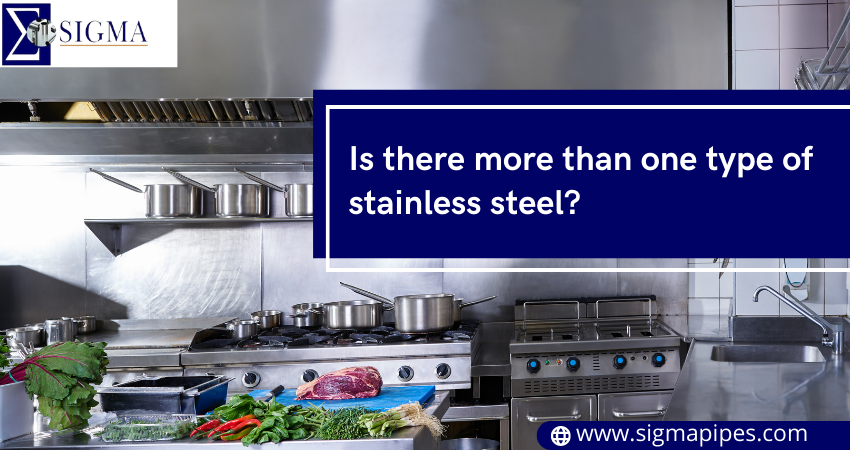This expansion of chromium gives stainless steel its remarkable stain and erosion-resistant properties; stainless steel square pipe is steel based on low carbon and made with some chromium. Due to the chromium in steel, an undetectable, consumption-opposing film of chromium oxide can form on its surface. The expansion of chromium and other components, such as molybdenum, nickel, and nitrogen, makes the steel more resistant to consumption and gives it different properties. Stainless steel manufacturing in India is also a result of this.
Many homes and businesses utilize stainless steel and its alloys due to their flexibility and strength. In addition to sheets and pipes, stainless steel products are manufactured by some of the best steel pipe companies in India.
In general, hardened steel refers to any metal with at least 10.5% chromium. A variety of treated stainless steels are available, each categorized under one of four general groups. Steel’s arrangement, properties, and application determine its grade. Having experience with grade numbers and gatherings provides quick insight into the steel’s appearance and application.
There are five distinct classes of stainless steel
Several factors determine the use and location of stainless steel round pipe.
The alloying components that influence their microstructure and give them their names distinguish each.
- Martensitic Treated stainless steel
- Ferritic Treated stainless steel
- Austenitic Treated stainless steel
- Duplex (ferritic-austenitic) Treated stainless steel
- Precipitation-Hardening (PH) Treated stainless steel
- Austenitic Stainless Steel
A high chromium and nickel content distinguishes austenitic stainless steels from other types. The weldability, strength, and consumption resistance of this metal make it suitable for use in both household cutlery and airplane parts. There is a further grading process.
- Low Carbon Grades (L Grades)
Welding with “L” grades provides additional durability. Low carbon steel appears by the letter “L” after its grade number. Maintain carbon levels below .03% to avoid carbide precipitation, which can lead to erosion. In welding systems (which may cause carbon precipitation) “L” grades are commonly used due to the high temperatures. Stainless steel plants normally offer these impeccable grades as double guaranteed, like 304/304L or 316/316L.
- High Carbon Grades (H Grades)
The carbon content of pure ‘H’ grades is capped at .10%. Despite extreme temperatures, carbon retains its strength. The letter “H” follows the pure grade number for these grades. 304V, 316LVM, 330, Biodur108, and Nitronic 60 are austenitic hardened steels.
- Ferritic Stainless Steel
Stainless steel ferritic is a well-known, high-quality material for indoor uses because it has low nickel content and a high degree of durability. Particularly when requiring contact with other destructive materials, they come in handy for their resistance to stress consumption and breaking. 430FR and 430FRH are types of ferritic hardened steel suitable for these purposes.
- Duplex Stainless Steel
Despite its almost 50/50 structure of austenitic and ferritic, this half-and-half is more grounded than either of its components at its beginning. As a result, duplex tempered steels are more resistant to consumption and breaking. A high ferritic content contributes to its well-finished appearance. The submerged oil industry uses duplex steels because they’re weldable and suitable for saltwater damage.
There are two kinds of duplex hardened steel: S31803 and S32205.
- Precipitation-Hardening (PH) Stainless Steels
It is possible to fortify and solidify precipitation by solidifying tempered steel by heat treatment. It offers the fashioner a unique combination of texture capacity, strength, ease of hotness treatment, and erosion resistance not found in any other material. The grades include 17Cr-4Ni (17-4PH) and 15Cr-5Ni (15-5PH).
- Martensitic
Martensitic steel’s high carbon content (1%) and prominent solidifying properties set it apart from other steels. The high strength of martensitic treated stainless steel makes it ideal for products ranging from instruments to turbine components. Stainless steels with martensitic treatment include 15-5PH, 17-4PH, 416, 420F, 420 MOD, 455, 465.
A noteworthy characteristic of stainless steel is its adaptability, recyclability, and solidity. Despite Sigma Pipes being a strong competitor in stainless steel rectangular sections, a lot depends on the type of steel it competes against. A general classification helps frame the numerous pieces and uses for the material.













